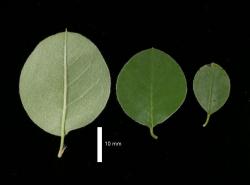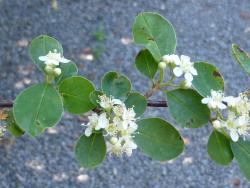- ≡ Cotoneaster nummularius var. soongoricus Regel & Herder, Bull. Soc. Imp. Naturalistes Moscou 39: 59 (1866)
Erect shrub 2 m tall, deciduous (a few leaves left by August). Branches angled upwards; branchlets red-brown and glossy; branchlet hairs dense, white, woolly; stipule 2.0–3.0 mm long, red, falling early, hairs dense, white. Leaves sparse on branches, 28–36 mm long, lamina 22–30 mm long, 20–26 mm wide, orbicular, plane, texture thin (160–180 µm), petiole 6 mm long, petiole hairs dense, white, woolly; leaf base obtuse; leaf apex rounded, apiculus apiculate, straight; lateral veins in 5–6 pairs, midvein only impressed above and projecting below; upper surface slightly rugose, moderate olive green (RHS 137B), matt, upper-surface hairs sparse, white, on midvein only; margins plane, hairs dense, white; lower surface glaucous, hairs dense, white.
Inflorescence a corymb of 1–10 flowers, 15 mm long, rachis hairs dense, white, woolly; pedicel 2.0 mm long, hairs moderately dense, white. Flowers 7.0 mm diameter. Hypanthium green, sepals 0.8 mm long, 1.6 mm wide, hairs moderately dense, white, woolly. Petals spreading, white in bud, white when open, 2.6 mm long, 2.5 mm wide, base not clawed, tuft of hairs present, petal margins entire but contorted. Stamens 13–15; filaments 1.9 mm long, white; anthers white, 1.1 mm long; styles 2, 2.0 mm long. Fruit not known.
An erect shrub, with red-brown glossy branchlets. Leaves deciduous, not crowded on branchlets, thin, matt on upper surface, orbicular, base of leaf obtuse, medium-sized. Flowers 1–10, petals white, spreading, a tuft of hairs at petal base, filaments and anthers white, styles 2.
Most similar to Cotoneaster hebephyllus and C. roseus in having a tuft of hairs at the petal base, and in having deciduous leaves that are soft in texture, matt and only sparsely hairy on the upper surface, glaucous and moderately densely hairy on the lower surface. It differs from C. roseus in having white petals that are spreading, not pink and upright. It differs from C. hebephyllus in having orbicular, not elliptic, leaves, and anthers white, not pink. Cotoneaster roseus is not known to be in cultivation in N.Z. now, but it has been in the past (Christchurch Botanic Gardens, 2008, CHR 610453).
Known at a single garden site in Canterbury, Port Hills, Cashmere, Cracroft Reserve, CHR 635009.
Flowering: mid to late October; Fruiting: not formed on the only known New Zealand plants
Tetraploid (Fryer & Hylmö 2009)





